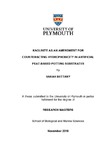Kaolinite as an Amendment for Counteracting Hydrophobicity in Artificial Peat-based Potting Substrates
| dc.contributor.supervisor | Nason, Mark | |
| dc.contributor.author | Bettany, Sarah | |
| dc.contributor.other | School of Biological and Marine Sciences | en_US |
| dc.date.accessioned | 2019-03-06T09:27:48Z | |
| dc.date.available | 2019-03-06T09:27:48Z | |
| dc.date.issued | 2018 | |
| dc.identifier | 10384782 | en_US |
| dc.identifier.uri | http://hdl.handle.net/10026.1/13438 | |
| dc.description.abstract |
It has been demonstrated in pot experiments at Duchy College Rosewarne, Cornwall, U.K. that adding kaolinite (china clay) to growing media results in an increase in plant biomass. However, the underlying reason for this response is unknown, though, it is speculated that it improves the plants’ ability to tolerate stressful conditions such as heat and drought. In this study four artificial organic substrates (peat, peat/green waste, John Innes no.2 and a bark-based substrate) containing different concentrations of kaolinite (0%, 5%, 10%, 20% and 40%) were tested for capillary rise and water drop penetration time (WDPT). In addition, plant growth experiments investigated biomass accumulation of Brassica juncea (green mustard) and Triticum aestivum (winter wheat) grown in pots in substrates containing a range of kaolinite concentrations (0%, 0.5%, 1%, 1.5%, 2%, 5%, 10%, 20%, 25%, 40%, 50% and 100% in different experiments). Capillary rise and WDPT tests showed that the presence of kaolinite significantly counteracted substrate hydrophobicity and the incorporation of Kaolinite in growing substrate increased biomass production in B. juncea in treatments (0%, 5%, 10%, 20% and 40%) when compared to those grown in substrates without Kaolinite. Further, the addition of Kaolinite (in the peat/green waste substrate) improved water penetration in substrates that were hydrophobic due to drought. The results of this study suggest that the addition of kaolinite in commercial potting composts may have a role to play in the management of irrigation in pot plant production. Kaolinite did not negatively affect biomass production in peat-based potting substrate, and does counteract hydrophobicity in lab tests, most likely due to its crystalline 1:1 structure, texture and hydrophilic nature. A tentative optimum concentration of 10% is suggested for its potential use as a substrate amendment, but more study is required. | en_US |
| dc.description.sponsorship | The Finnis Scott Foundation | en_US |
| dc.description.sponsorship | The Perry Foundation | en_US |
| dc.language.iso | en | |
| dc.publisher | University of Plymouth | |
| dc.rights | Attribution-NoDerivs 3.0 United States | * |
| dc.rights.uri | http://creativecommons.org/licenses/by-nd/3.0/us/ | * |
| dc.subject | Hydrophobicity | en_US |
| dc.subject | Wettability | en_US |
| dc.subject | Substrates | en_US |
| dc.subject | Artificial substrates | en_US |
| dc.subject | Potting compost | en_US |
| dc.subject | Growing media | en_US |
| dc.subject | Kaolin | en_US |
| dc.subject | Kaolinite | en_US |
| dc.subject | China clay | en_US |
| dc.subject.classification | ResM | en_US |
| dc.title | Kaolinite as an Amendment for Counteracting Hydrophobicity in Artificial Peat-based Potting Substrates | en_US |
| dc.type | Thesis | |
| plymouth.version | publishable | en_US |
| dc.identifier.doi | http://dx.doi.org/10.24382/930 | |
| dc.rights.embargoperiod | No embargo | en_US |
| dc.type.qualification | Masters | en_US |
| rioxxterms.version | NA | |
| plymouth.orcid_id | 0000-0002-0861-5187 | en_US |
Files in this item
This item appears in the following Collection(s)
-
01 Research Theses Main Collection
Research Theses Main



